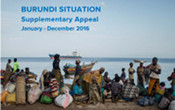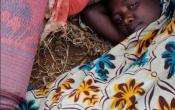United Republic of Tanzania
Operation: United Republic of Tanzania
Location
{"longitude":35,"latitude":-6,"zoom_level":0}
Latest update of camps and office locations 13 Jan 2016. By clicking on the icons on the map, additional information is displayed.
Key Figures
| 2015 end-year results | |
| 96% | of Burundian refugees were registered biometrically |
| 45,000 | Burundian households received core relief items |
| 97% | of primary school-aged refugee children in Nyarugusu camp were enrolled in primary education |
| 152,936 | former Burundian refugees received their citizenship certificates |
| 2016 planning figures | |
| 203,941 | people of concern having their naturalization facilitated |
| 15 | projects benefiting local and displaced communities implemented |
| 35,500 | refugee children registered and receiving documentation under the regular birth registration procedure |
| 30,356 | refugee children enrolled in primary education |
| 6,000 | people of concern resettled |
More Information
People of Concern
52%
Increase in
2015
2015
| 2015 | 382,620 |
| 2014 | 252,357 |
| 2013 | 264,762 |

[["Refugees",211845],["Asylum-seekers",2150],["Others of concern",168625]]
Loading ...
Budgets and Expenditure for United Republic of Tanzania
< Back
2015
{"categories":[2012,2013,2014,2015,2016],"budget":[79.97641905,39.65703876,38.21491383,134.15516444,108.91259792],"expenditure":[21.51766799,19.39590816,24.6811937,48.87004149,null]}
{"categories":[2012,2013,2014,2015,2016],"p1":[21.4658967,15.86371529,23.19500923,118.73635308,96.44835551],"p2":[null,null,null,null,null],"p3":[58.51052235,23.79332347,15.0199046,15.41881136,12.46424241],"p4":[null,null,null,null,null]}
{"categories":[2012,2013,2014,2015,2016],"p1":[14.79110555,13.24639973,20.0803866,42.24403878,null],"p2":[null,null,null,null,null],"p3":[6.72656244,6.14950843,4.6008071,6.62600271,null],"p4":[null,null,null,null,null]}
Loading ...
CHOOSE A YEAR
- 2014
- 2015
- 2016
Working environment
- Before April 2015, Tanzania hosted 64,000 refugees in Nyarugusu camp, which was the only remaining refugee camp in the country. By year end, the arrival of 123,000 refugees fleeing political tensions in Burundi was recorded.
- The growing refugee population in Nyarugusu prompted the Government of Tanzania to open a new camp, Nduta, in October 2015. The Government also decided to establish two additional camps in 2016, in Mtendeli and Karago.
- The naturalization and local integration programme for over 162,000 former 1972 Burundian refugees commenced, with some 153,000 new citizens receiving their citizenship certificates in 2015.
Population trends
- Before the arrival of Burundian refugees in the latter part of 2015, the refugee population in Nyarugusu camp comprised some 60,000 Congolese, 3,800 Burundians and 170 refugees of other nationalities.
- By the end of 2015, 38,000 refugees were residing in Nduta camp, and Nyarugusu camp’s refugee population rose to 150,000. The population in both camps comprised 66 per cent Burundians and 34 per cent Congolese; nearly two-thirds were children under the age of 18.
- 193,000 were registered in the old settlements of Katumba, Mishamo and Ulyankulu, including over 162,000 naturalized people.
- In July 2015, the group resettlement of approximately 30,000 Congolese refugees to the United States began.
Achievements and impact
- Since April 2015, prima facie refugee status has been granted to some 123,000 Burundian refugees.
- Approximately 2,300 refugees were resettled, while 6,800 applications were submitted, surpassing the annual target of about 5,000.
- As an immediate response to the influx, a total of 7,100 family shelters, 290 partitioned mass shelters and 7,000 tents were provided to Burundian refugees.
- Education was provided to some 34,000 Congolese refugee students, as well as to 33,700 Burundian refugees.
- Effective referral mechanisms were established to ensure that some 960 survivors of sexual and gender-based violence (SGBV) received appropriate multi-sectoral support.
Unmet needs
- Refugees could not leave the camps, hindering opportunities for self-reliance and creating dependency on humanitarian aid.
- A significant number of additional classrooms were needed in the camps, and improvements were needed to increase access to post-secondary education, lower school dropout rates and support youth programmes.
- The scarcity of firewood exposed women and children to the risks of SGBV, exploitation and other forms of intimidation. The lack of fuel-efficient stoves exacerbated this risk, increased deforestation near Nyarugusu camp and heightened tensions between refugees and the host community.
Working environment
UNHCR will work with the Government of the United Republic of Tanzania (Tanzania) and partners to safeguard the rights and entitlements of refugees and other people of concern by promoting an enabling environment for the country to adapt its national legislation to the international instruments to which it has acceded. The Government has committed to aligning domestic law to international standards and to issue birth certificates and identification cards in 2015. This will improve refugee access to social services.Sexual and gender-based violence (SGBV) remains a challenge for refugees; some harmful traditional practices perpetuate discrimination against women and children. In 2015, UNHCR will work to promote women’s rights and refugees’ free access to SGBV prevention and response mechanisms.
Continuing insecurity in the eastern part of the Democratic Republic of the Congo (DRC) remains an important obstacle to voluntary repatriation. Meanwhile, in 2015, UNHCR will continue implementing a regional resettlement strategy for Congolese refugees.
Following the suspension in June 2011 of the naturalization and local integration programme that had begun, the President of Tanzania in September 2014 authorized the relevant authorities to commence the issuance of naturalization certificates to over 162,000 former Burundian refugees. This new development calls on UNHCR to rapidly respond to this opportunity to find permanent solutions for this population.
UNHCR, together with partners, will support the Government of Tanzania in the formulation and implementation of programmes that strengthen livelihoods and local integration in the old settlements of Katumba, Mishamo and Ulyankulu, where the former Burundian refugees reside.
For decades, the Government and people of Tanzania have been hospitable to refugees. This support is expected to continue in 2015 with the implementation of legal and socio-economic measures for the newly naturalized Burundian refugees and the continued provision of security for the Nyarugusu camp, as well as the three old settlements of Katumba, Mishamo and Ulyankulu.
Needs and strategies
In 2015, UNHCR will continue focusing on protection activities, with particular emphasis on reducing the risk of SGBV for refugees. There are consistently high levels of SGBV and sexual exploitation and abuse in Nyarugusu camp, mainly resulting from harmful traditional practices affecting women and girls. This will be mitigated through education, alternative energy solutions, women’s empowerment, and livelihoods.UNHCR will also prioritize refugee empowerment by reducing protection risks and aiming to increasing resilience, particularly for refugee women.
UNHCR will continue providing assistance in the key sectors of health, nutrition, water and sanitation, education and community empowerment. Education is supported by communities, with limited government support in the form of teaching aids. Classroom space is inadequate and a double-shift system is currently in place. Annually, 54 primary schools graduate more than 3,000 pupils, while the seven available secondary schools can only admit 500 students. UNHCR will advocate for their admission to mainstream secondary schools.
The United States Government has agreed to resettle more than 30,000 Congolese (DRC) refugees from Tanzania in 2015 as part of a regional resettlement strategy.
Another priority for UNHCR in Tanzania will be the local integration of the newly naturalized 1972 Burundian refugees.





